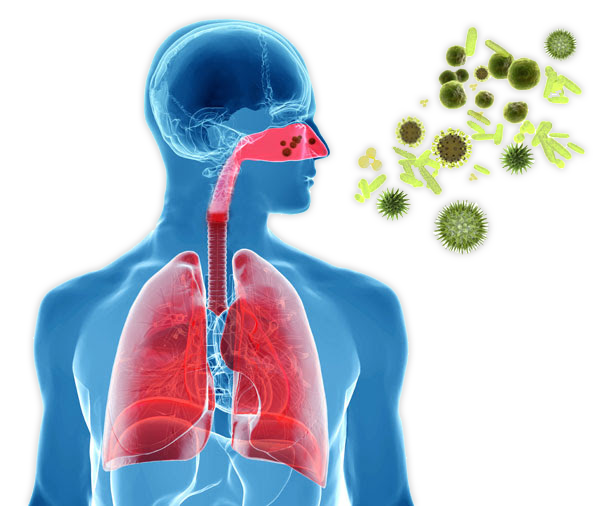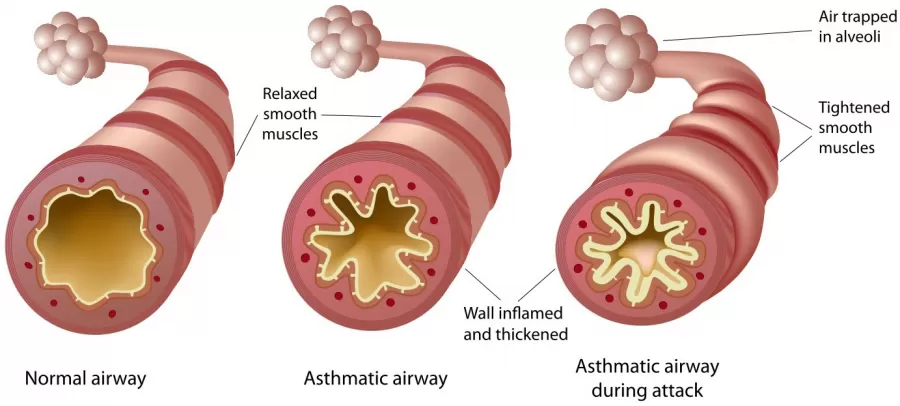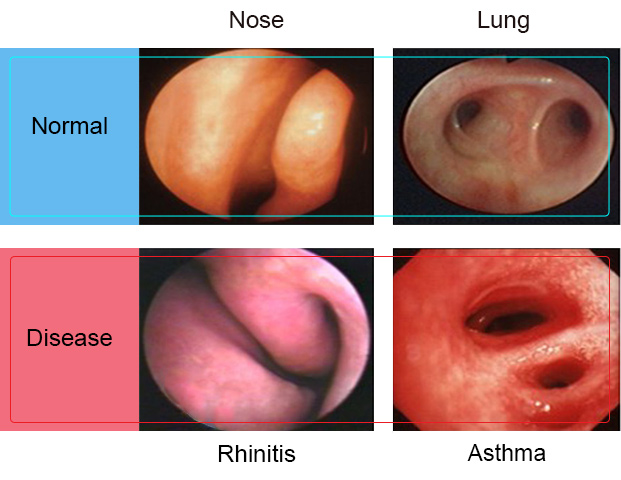-
ALLERGY IQ
Allergies and Health -

Children & Inhalant Allergies Allergies are a chronic disorder that starts early in life. It is one of the most common health conditions that affects one out of three children in the U.S. -

Oral Allergy Syndrome is Not Food Allergy Oral allergy syndrome (OAS) is often confused with food allergies but is not the same thing and is more common than people realize. -

Allergies & Poor Sleep Sleep is a huge factor in health and wellbeing. If your quality of sleep is affected by allergies, know that there are solutions. -

Hay Fever (Allergic Rhinitis) Unlike the common cold, hay fever is not caused by a virus. Instead, it’s caused by an allergic response to indoor/outdoor allergens like pollens, mold, mites.
-

How Allergies and Asthma are Related People who suffer from allergies can develop asthma and those with asthma can suffer from allergies. Both conditions are closely related. -

Allergy Load Find out why chronic allergic disease progresses with age, learn about Total Allergy Load, stressors, and why you don't want to delay allergy treatment.
Treating Allergies -

Managing Your Allergies Allergies are a serious burden on your immune system, not just runny nose, sneezing, and itchy eyes. Learn how to safely treat allergies for full-body health. -

Testing For Allergies: Is It Necessary? Allergy testing is a necessary step in treating symptoms of allergic rhinitis. Skin and blood tests can find the source and ideal treatment for your symptoms. -

Nasal Steroid Sprays Due to their high efficacy and safety, nasal steroid sprays are considered the first line of treatment for allergic rhinitis and other nasal conditions. -

Nasal Obstruction, Inhalant Allergies, and Turbinate Reduction Inhalant allergies can cause nasal obstruction and enlarged turbinates. Learn about the causes and treatment options for your chronic congestion.
-
- ALLERGY EXPLORER
- ALLERGY QUIZ
- SEARCH
- ACCOUNT
How Allergies and Asthma are Related
The Unified Airway Disease

Did you know that close to 50 million Americans suffer from at least one form of inhalant allergy? Moreover, did you know that 25 million Americans suffer from asthma? Though surprising, there are even more shocking facts about the relationship between allergies and asthma.
There is a strong correlation between allergies and asthma. People who suffer from allergies can develop asthma, and those living with asthma can experience increased symptoms due to environmental allergies. The two conditions are closely related, and understanding the connection can help keep both under control.
Every human being has one respiratory system, divided into upper and lower compartments. Your upper respiratory compartment includes the nose, pharynx (throat), and the upper part of the trachea (windpipe). The lower part contains the rest of the trachea, the bronchi, and the lungs. The entire airway is connected. Every time you take a breath, air goes through the entire system to the lungs, where the blood carries oxygen to the rest of your body.
If you think about it, it makes sense that whatever affects the upper part of the respiratory system. For example, allergens like dust, mold spores, and pollen affect the upper part of the system, and in turn affect the lower part. This realization led scientists to believe that there is a connection between upper airway disease (allergies) and lower airway disease (asthma).
The mechanism of such a connection is not yet fully understood, but numerous pieces of evidence suggest the link is legitimate. You can’t change your genetics to control your asthma, and sometimes it is impossible to avoid allergens. But, understanding this link can help you gain enough knowledge to prevent triggers and live with decreased symptoms.
Mechanism of Asthma
An asthmatic attack means that the lower part of the airway gets congested, both by the secretion of mucus and the contraction of the lower airway muscles. It leads to shortness of breath, wheezing, coughing, chest tightness, and sometimes bluish lips or loss of consciousness.

Asthma attacks happen when asthmatic sufferers are subjected to known triggers such as chemical irritants or smoke. An attack can also occur in relation to some viral infections or after exerting intense effort during exercise.
Mechanism of an allergic attack
Allergic attacks work differently. They are your body’s response to allergens through the action of your immune system. If you have allergies, your immune system is constantly in hyperdrive. It considers a naturally harmless substance like pollen to be a foreign attacker on the body, triggering the allergic response.
This response manifests through the known signs and symptoms of allergy. These symptoms are usually mild including, itching, redness, swelling, runny nose, and sneezing. In some cases, the symptoms are more severe, including anaphylaxis, and can even be fatal.
How are Asthma and Allergy related
Recent studies have revealed that asthma and allergy are often related and interchangeable, in that a person suffering from allergies can also develop asthma and vice versa.
A person living with asthma can develop an asthmatic attack – along with an allergic reaction - when exposed to their trigger allergens. In that case, the symptoms are not confined to the upper airway with only itching and redness. They can also make their way to the lower airway with chest tightness and wheezing.
This reaction happens because the chemicals released by the immune response to the invading allergen extend to the lower part of the airway. The lower trachea, bronchi, and lungs react to these chemicals by releasing mucus and other secretions. Muscle contractions occur to keep the allergen from invading even deeper into the system. As a result, the signs and symptoms of asthma - rather than allergy - start to appear. This discovery has led to the emergence of a new concept called the unified airway disease (UAD).
There is another link to consider. In some cases, an asthma attack happens when irritants contact the skin or other body parts aside from the airway. It can even result from some food allergies. This phenomenon is known as Allergic Asthma.
The Unified Airway Disease (UAD) explained

When scientists discovered the “Nose-Lung” interaction, they started to look into the causes and other possible explanations for such an interaction. This concept is still undergoing research, but there are a few explanations for the connection:
Anatomical and Histological evidence:
The upper and lower airways are lined with similar cells, and they all act in unison to filter the air from harmful particles and get clean oxygen to the lung-blood interface. That same anatomical structure may explain why diseases of both parts are related.
Epidemiological evidence:
Studies show that up to 38% of people with Allergic Rhinitis (AR) also have asthma, while up to 80% of people with asthma suffer from AR as well.
Treatment evidence:
Some treatments that can ease asthma symptoms are also used to treat allergic conditions like AR. For example, intranasal corticosteroids used in the treatment of AR decrease the symptoms of asthma. Additionally, leukotriene receptor antagonists – used in long-term therapy for asthma patients – also ease the symptoms of AR.
How this knowledge could affect your lifestyle
This knowledge is invaluable if you suffer from both asthma and allergies. You should identify the triggers that cause your allergic reactions and try to avoid them as much as possible. That way, you can also avoid falling victim to asthma and asthmatic attacks.
Similarly, asthmatics can also work with an ENT allergist to establish a link between their asthma and inhalant allergies through skin testing. Allergy skin tests can identify specific allergic triggers, so the patient knows to avoid them.
They can also help direct the appropriate active and preventative medications to control symptoms and asthma attacks. Some medicines and remedies - as explained above - can be used to treat and manage both conditions simultaneously.
However, the most significant benefit of specific allergy skin testing is that it allows the implementation of the only treatment that can permanently improve and prevent progression in asthma - immunotherapy to inhalant allergies. The easiest and safest way to specifically desensitize a person to their inhalant allergies is with sublingual allergy drops.
The link between asthma and various allergies is now fairly well-established. Although the mechanism is not yet fully understood, it is of great benefit to you to figure out if that connection is happening inside your body. Knowledge is the basis of treatment, and with that knowledge, you can help keep your conditions under control and enjoy a healthy and happy lifestyle.
Additional resources
- Asthma - Symptoms and causes - Mayo Clinic
- Allergies and asthma: They often occur together
- The Connection Between Allergies and Asthma
- The Nose and the Lung: United Airway Disease?
- Chronic Rhino-Sinusitis and Asthma: Concept of Unified Airway Disease (UAD) and its Impact in Otolaryngology
- Asthma and Allergy Research and facts